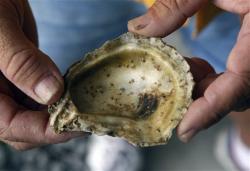Oil Dispersants’ Effects On Seafood Still A Mystery
September 8, 2010 | 1 min to read

LOS ANGELES — In the wake of the BP oil spill, gaping questions remain about a key tool used during cleanup: the nearly 2 million gallons of chemical dispersants sprayed over the water or onto the gushing wellhead on the seafloor. Do the chemicals help recovery, hinder it — or neither?
Just as dishwashing detergent breaks grease on dirty plates into bits, dispersants help turn a slick of oil into droplets a hair's breadth in size. In droplet form, oil is more easily pulled under by currents, away from birds, otters, seaweed and other marine life near the surface. And because droplets present a greater surface area of oil to water, dispersants should, in theory, permit microbes to chew up oil far faster.
Yet despite more than half a century of dispersant use in oil spill cleanups, the long-term effects that dispersants or dispersant-treated oil have on marine life remain as opaque as a layer of crude.
Scientists say they still don't know whether dispersants truly enable bacteria to digest spilled oil more quickly or whether dispersed oil is safer for marine life than untreated slicks.
To read the rest of the story, please go to: Los Angeles Times.
